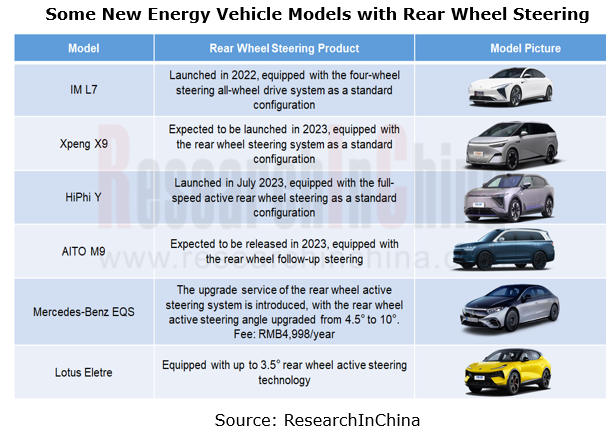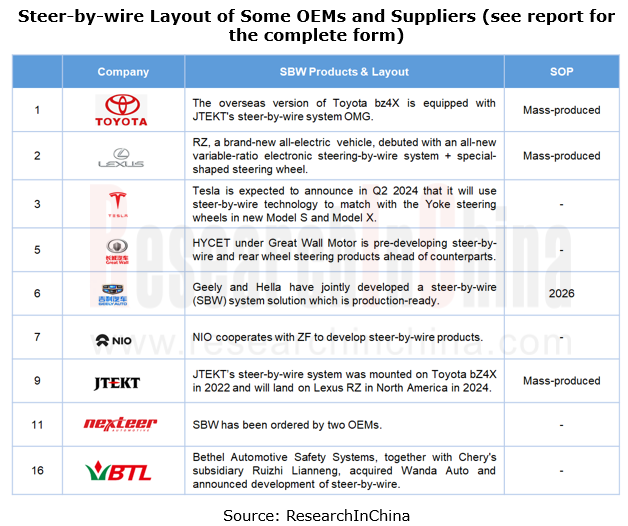Passenger Car Intelligent Steering Industry Report, 2023 released by ResearchInChina combs through and studies the status quo of passenger car intelligent steering and the product layout of OEMs, suppliers, and supply chains, and predicts the future development trends of passenger car intelligent steering.
1. The penetration rate of electric power steering (EPS) in the passenger car market almost hits the peak, and the iteration and upgrading of products reflect the current development direction.
From 2020 to 2023, the penetration of EPS in the Chinese passenger car market remained at a high level. In the next stage, EPS will head in the direction of high performance.

By the installation position of booster motor, EPS can be divided into four types: column EPS (C-EPS), pinion EPS (P-EPS), rack EPS (R-EPS) and dual pinion EPS (DP-EPS). In terms of transmission efficiency from high to low, the ranking is R-EPS/DP-EPS > P-EPS > C-EPS. As mid-to-high-end smart electric vehicles boom, the steering system is being upgraded from C-EPS to R-EPS and DP-EPS. The content-per-car value of the latter two is higher than that of C-EPS, and the iteration of the EPS product structure brings value increment.

2. In the process of upgrading from EPS to SBW (steer-by-wire), redundant EPS and rear wheel steering become the transitional form.
L3 driving assistance requires EPS to still have a certain power-assisting capability in the event of a single point failure. Under this requirement, redundant EPS becomes the key component of L3+ intelligent driving systems.

At present, OEMs and suppliers have made related product layout:
 Bosch HASCO's HE3r B3, which was rolled out in April 2023, adopts a 50%+50% redundancy solution. The two control loops have independent power supplies and communication modules and work together. If a functional failure occurs on either of them, 50% of the steering force can cover most working conditions and ensure constant driving.
Bosch HASCO's HE3r B3, which was rolled out in April 2023, adopts a 50%+50% redundancy solution. The two control loops have independent power supplies and communication modules and work together. If a functional failure occurs on either of them, 50% of the steering force can cover most working conditions and ensure constant driving.
 T-RES, a redundant electronically controlled steering system of Trinova, integrates dual winding motors, dual drive circuits, dual sensors and dual power management systems to meet the redundancy requirements of L3 autonomous driving.
T-RES, a redundant electronically controlled steering system of Trinova, integrates dual winding motors, dual drive circuits, dual sensors and dual power management systems to meet the redundancy requirements of L3 autonomous driving.
 The fully redundant DP-EPS of NASN has the maximum rack force of 13.5KN, suitable for medium SUVs, large SUVs, MPVs, pickup trucks and other pan-passenger vehicles. The whole series uses 6-phase dual winding motors to satisfy the requirements of ADAS and L3+ autonomous driving.
The fully redundant DP-EPS of NASN has the maximum rack force of 13.5KN, suitable for medium SUVs, large SUVs, MPVs, pickup trucks and other pan-passenger vehicles. The whole series uses 6-phase dual winding motors to satisfy the requirements of ADAS and L3+ autonomous driving.
 HYCET under Great Wall Motor is about to mass-produce dual redundant EPS with the maximum thrust of 14kN to enable L3+ autonomous driving.
HYCET under Great Wall Motor is about to mass-produce dual redundant EPS with the maximum thrust of 14kN to enable L3+ autonomous driving.
Redundant EPS will become a core technology in L3+ intelligent driving scenarios before mass production and application of steer-by-wire.
Rear wheel steering, as a supplement to front wheel steering, was originally used in large luxury cars and SUVs, such as BMW 5/7 Series and Audi Q7/8. On the one hand, rear wheel steering technology based on electrical operation is easier to implement on an all-electric platform. On the other hand, electric vehicles on an all-electric platform generally have a long wheelbase (the battery must be placed between the front and rear axles) which increases the turning radius, while rear wheel steering technology offers much higher flexibility. In recent years, as electrification has become widespread rapidly, rear wheel steering has landed on more models such as Xpeng X9, AITO M9 and IM L7.

3. Suppliers and OEMs quicken their pace of deploying steer-by-wire, with more production models.
OEMs:
 Toyota and Tesla have submitted patent applications for steer-by-wire technology.
Toyota and Tesla have submitted patent applications for steer-by-wire technology.
 Great Wall Motor and Changan adopt their self-developed steer-by-wire products to deploy steer-by-wire.
Great Wall Motor and Changan adopt their self-developed steer-by-wire products to deploy steer-by-wire.
 Geely and Hella have jointly developed a steer-by-wire (SBW) system which is production-ready.
Geely and Hella have jointly developed a steer-by-wire (SBW) system which is production-ready.
 NIO and ZF cooperate on steer-by-wire products.
NIO and ZF cooperate on steer-by-wire products.
Suppliers:
 Nexteer Automotive has secured steer-by-wire system orders from two OEMs.
Nexteer Automotive has secured steer-by-wire system orders from two OEMs.
 Bethel Automotive Safety Systems, together with Chery's subsidiary Ruizhi Lianneng, acquired Wanda Auto for a layout shift to steer-by-wire R&D.
Bethel Automotive Safety Systems, together with Chery's subsidiary Ruizhi Lianneng, acquired Wanda Auto for a layout shift to steer-by-wire R&D.
 JTEKT’s steer-by-wire system was available to Toyota bZ4X in 2022 and will land on Lexus RZ in 2024.
JTEKT’s steer-by-wire system was available to Toyota bZ4X in 2022 and will land on Lexus RZ in 2024.

At present, many OEMs and suppliers make many deployments in steer-by-wire, but with a low product penetration. Nexteer Automotive forecasts that it is difficult for steer-by-wire to gain pace in the next 2 or 3 years.
The policy environment has become more relaxed in recent years. The development of steer-by-wire is driven by the demand for intelligent chassis and stimulated by policies. From the implementation of the new national automotive steering standard to the release of Steer-by-wire Technology Roadmap, steer-by-wire has been production-ready in terms of policies.
 On January 1, 2022, the new national automotive steering standard was officially implemented, deleting the 20-year-old requirement that full-power steering mechanisms should not be installed (steer-by-wire is full-power steering);
On January 1, 2022, the new national automotive steering standard was officially implemented, deleting the 20-year-old requirement that full-power steering mechanisms should not be installed (steer-by-wire is full-power steering);
 In April, 2022, the exposure draft of the Steer-by-wire Technology Roadmap was officially released. The overall goal is to realize the world’s leading steer-by-wire for L3+ and L4+ autonomous driving in 2025 and 2030, with the penetration of steer-by-wire up to 5% and 30% and the autonomy rate of core components (controller, motor, etc.) higher than 20% and 50%, respectively.
In April, 2022, the exposure draft of the Steer-by-wire Technology Roadmap was officially released. The overall goal is to realize the world’s leading steer-by-wire for L3+ and L4+ autonomous driving in 2025 and 2030, with the penetration of steer-by-wire up to 5% and 30% and the autonomy rate of core components (controller, motor, etc.) higher than 20% and 50%, respectively.
 In June 2023, the Ministry of Industry and Information Technology and other four ministries further proposed that "the automotive industry should focus on steer-by-wire".
In June 2023, the Ministry of Industry and Information Technology and other four ministries further proposed that "the automotive industry should focus on steer-by-wire".
Autonomous Driving Domain Controller and Central Computing Unit (CCU) Industry Report, 2025
Research on Autonomous Driving Domain Controllers: Monthly Penetration Rate Exceeded 30% for the First Time, and 700T+ Ultrahigh-compute Domain Controller Products Are Rapidly Installed in Vehicles
L...
China Automotive Lighting and Ambient Lighting System Research Report, 2025
Automotive Lighting System Research: In 2025H1, Autonomous Driving System (ADS) Marker Lamps Saw an 11-Fold Year-on-Year Growth and the Installation Rate of Automotive LED Lighting Approached 90...
Ecological Domain and Automotive Hardware Expansion Research Report, 2025
ResearchInChina has released the Ecological Domain and Automotive Hardware Expansion Research Report, 2025, which delves into the application of various automotive extended hardware, supplier ecologic...
Automotive Seating Innovation Technology Trend Research Report, 2025
Automotive Seating Research: With Popularization of Comfort Functions, How to Properly "Stack Functions" for Seating?
This report studies the status quo of seating technologies and functions in aspe...
Research Report on Chinese Suppliers’ Overseas Layout of Intelligent Driving, 2025
Research on Overseas Layout of Intelligent Driving: There Are Multiple Challenges in Overseas Layout, and Light-Asset Cooperation with Foreign Suppliers Emerges as the Optimal Solution at Present
20...
High-Voltage Power Supply in New Energy Vehicle (BMS, BDU, Relay, Integrated Battery Box) Research Report, 2025
The high-voltage power supply system is a core component of new energy vehicles. The battery pack serves as the central energy source, with the capacity of power battery affecting the vehicle's range,...
Automotive Radio Frequency System-on-Chip (RF SoC) and Module Research Report, 2025
Automotive RF SoC Research: The Pace of Introducing "Nerve Endings" such as UWB, NTN Satellite Communication, NearLink, and WIFI into Intelligent Vehicles Quickens
RF SoC (Radio Frequency Syst...
Automotive Power Management ICs and Signal Chain Chips Industry Research Report, 2025
Analog chips are used to process continuous analog signals from the natural world, such as light, sound, electricity/magnetism, position/speed/acceleration, and temperature. They are mainly composed o...
Global and China Electronic Rearview Mirror Industry Report, 2025
Based on the installation location, electronic rearview mirrors can be divided into electronic interior rearview mirrors (i.e., streaming media rearview mirrors) and electronic exterior rearview mirro...
Intelligent Cockpit Tier 1 Supplier Research Report, 2025 (Chinese Companies)
Intelligent Cockpit Tier1 Suppliers Research: Emerging AI Cockpit Products Fuel Layout of Full-Scenario Cockpit Ecosystem
This report mainly analyzes the current layout, innovative products, and deve...
Next-generation Central and Zonal Communication Network Topology and Chip Industry Research Report, 2025
The automotive E/E architecture is evolving towards a "central computing + zonal control" architecture, where the central computing platform is responsible for high-computing-power tasks, and zonal co...
Vehicle-road-cloud Integration and C-V2X Industry Research Report, 2025
Vehicle-side C-V2X Application Scenarios: Transition from R16 to R17, Providing a Communication Base for High-level Autonomous Driving, with the C-V2X On-board Explosion Period Approaching
In 2024, t...
Intelligent Cockpit Patent Analysis Report, 2025
Patent Trend: Three Major Directions of Intelligent Cockpits in 2025
This report explores the development trends of cutting-edge intelligent cockpits from the perspective of patents. The research sco...
Smart Car Information Security (Cybersecurity and Data Security) Research Report, 2025
Research on Automotive Information Security: AI Fusion Intelligent Protection and Ecological Collaboration Ensure Cybersecurity and Data Security
At present, what are the security risks faced by inte...
New Energy Vehicle 800-1000V High-Voltage Architecture and Supply Chain Research Report, 2025
Research on 800-1000V Architecture: to be installed in over 7 million vehicles in 2030, marking the arrival of the era of full-domain high voltage and megawatt supercharging.
In 2025, the 800-1000V h...
Foreign Tier 1 ADAS Suppliers Industry Research Report 2025
Research on Overseas Tier 1 ADAS Suppliers: Three Paths for Foreign Enterprises to Transfer to NOA
Foreign Tier 1 ADAS suppliers are obviously lagging behind in the field of NOA.
In 2024, Aptiv (2.6...
VLA Large Model Applications in Automotive and Robotics Research Report, 2025
ResearchInChina releases "VLA Large Model Applications in Automotive and Robotics Research Report, 2025": The report summarizes and analyzes the technical origin, development stages, application cases...
OEMs’ Next-generation In-vehicle Infotainment (IVI) System Trends Report, 2025
ResearchInChina releases the "OEMs’ Next-generation In-vehicle Infotainment (IVI) System Trends Report, 2025", which sorts out iterative development context of mainstream automakers in terms of infota...